The Grizzle Blog


When built the right way, B2B influencer relationships can be invaluable.
- They can lead to business development opportunities
- They can help you distribute your owned content to a larger audience
- They provide an opportunity to work on co-marketing projects together
The trouble is, most advice begins and ends with “provide value", which usually comes in the form of sharing content, mentioning them on social, and commenting on their blog posts.
But busy influencers are bombarded with these social notifications and cold emails on a daily basis. What influencers really need help with is getting their message, brand, and story in front of a larger audience.
In this guide, you’ll learn how to build long-term, meaningful relationships with influencers by getting them in front of a wider audience. You’ll learn how to engage with them, create content for other people’s audiences and create win-win scenarios for all involved.
The best bit? You get to create amazing content for a wider audience in the process.
Here’s how.
Identify relevant influencers
Not all influencers are made equal. And those you target will depend on your marketing goals.
For example, if you’re looking to establish co-marketing efforts (e.g. a co-branded eBook) with another non-competing brand, you’ll want to target senior marketers.
Perhaps you’re trying to expand your audience? Then you’ll want to engage with thought leaders who create great content for a large, engaged audience.
You should already have an idea of who you want to connect with. But you might also be looking for other opportunities outside of your “frame of reference.”
Here are some techniques to identify the best thought leaders in your space.
1. Use BuzzSumo for data-driven validation
Influencers are already sharing great content. You just need to find it.
BuzzSumo is just the tool for this job. With it, we can identify top-performing content and the influencers who shared it.
Let’s say we want to engage with influencers interested in chatbots. Type a keyword (e.g. “chatbot marketing”) into BuzzSumo and look at the top results:

Click on “View Sharers.” You’ll be taken to list of Twitter users who shared this content:
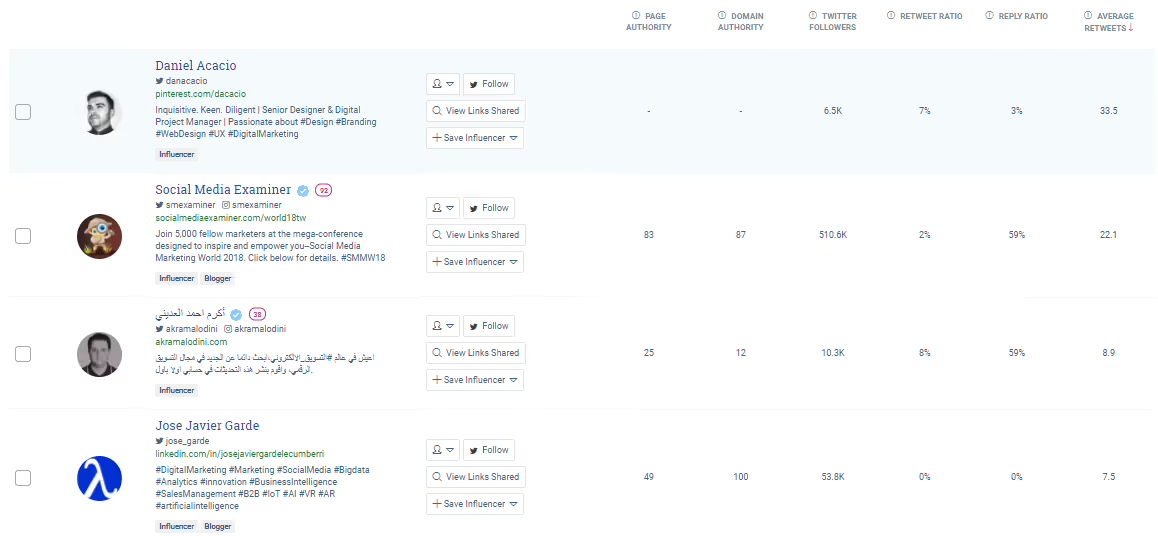
If you’re on the free version of BuzzSumo, order the list by Twitter Followers and identify individuals who would be a good fit.
For those on the premium version, we can download a CSV and perform some data wrangling. Click the “Export” button at the top right of the list and select “CSV.”
In Excel or Google Sheets, filter the data as follows:
- num_followers: > 5,000
- person_type: deselect any with [company]
- num_followers: order by largest to smallest
- Place name, URL and bio columns together (you may need to paste filtered data into a new spreadsheet to do this)
Moving these columns together makes it easy to sort through the list. You want to find users that have authority beyond the size of their followers.
Phrases such as “author,” “CEO” and “founder” are all indicators of legitimate influencers. Ignore users with their Pinterest or Facebook profiles listed.
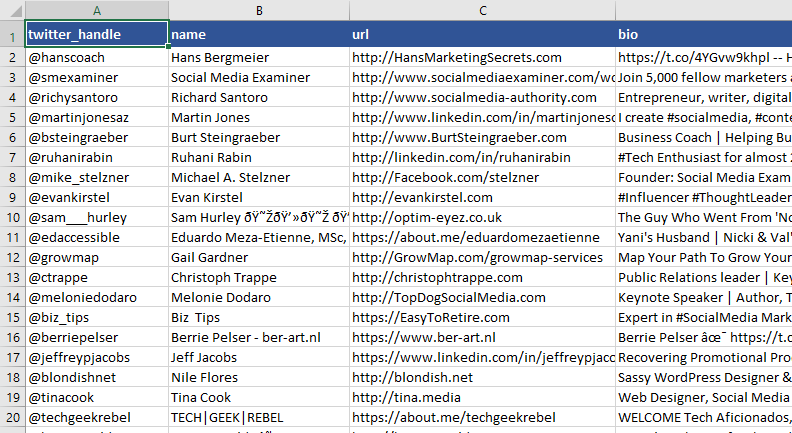
Add these to your list of target influencers.
2. Find Popular Brands to Partner With
When we think of influencers in the B2B space, we often think of bloggers, authors, and thought leaders.
While there’s some overlap, we often overlook “organizational leaders” – the senior decision makers and movers and shakers who work for other brands.
There are several benefits to strategic partnerships like these:
- They can help you reach a larger audience
- You can establish a partnerships to promote your content to each other’s audience
- You can create co-branded content
For the sake of this guide, we’re going to focus on co-branded content.
So, what exactly is co-branded content?
Co-branded content is a long-form asset (usually an eBook, report or webinar) co-authored by two (or more) brands. It helps increase the awareness and authority of both brands while generating qualified leads.
When starting up his agency, KlientBoost, Jonathan Dane decided to sacrifice “owned” content for partnerships. He identified software companies with access to his ideal clients and created co-branded eBooks with them:

As a result, KlientBoost grew from nothing to $1 million in revenue within a year. That’s the power of other people’s audiences.
Find brands using the BuzzSumo technique above. This time, include companies in your search. Look for influencers who have their company and job title in the bio.
LinkedIn is another great place to find potential partners. Using the advanced search features, you can find individuals within companies who would make great partners:
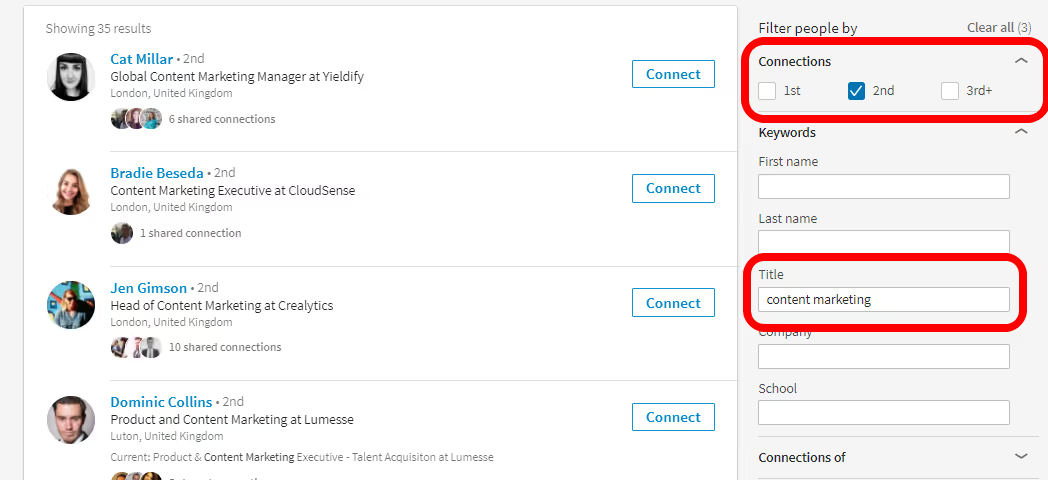
Tracking influencer activity & metrics
When identifying target influencers, you must keep track of the right metrics, activities and contact information.
This information includes any engagement touchpoints, as well as audience metrics.
Let’s break down the kind of information you should be collecting:

Social engagement can include likes, shares, and Tweets. But you need to get into the interview phase as quickly as possible.
As you’re aiming to add value through content, you should see a generous response rate during the outreach phase. We’ll cover influencer engagement in step 3.
Step 2: Creating Insanely Valuable Influencer Content
Once you’ve created a list of influencer targets, you’ll need a topic that brings them together.
There are two ways you can do this. The first is to make them the central focus of your content.
This is exactly what I did when writing a guest post for CrazyEgg, titled “7 Side Projects That Became Marketing Engines.” I reached out to marketers at the organizations featured, asking questions to get insights on their experiences on those projects.
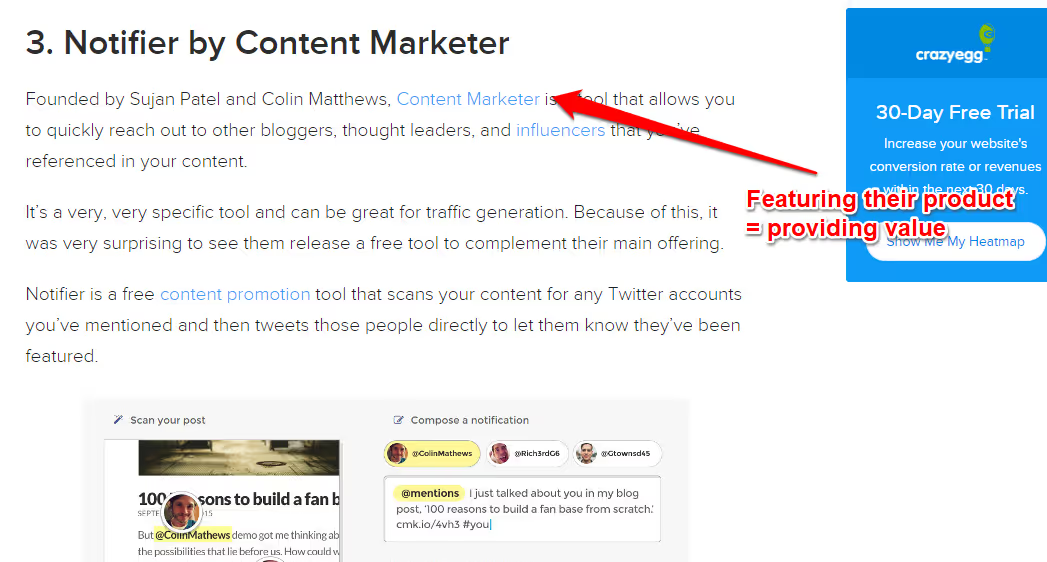
The second approach is to find a common theme that links your content to your target influencers.
Let’s say you’re writing a piece on content distribution, and you want to connect with CMOs at technology companies. The approach would look like this:
- Position your article as a content distribution guide for SaaS companies
- Identify 10 to 20 CMOs with access to your audience/work at target accounts
- Interview them about their distribution strategy, predictions, and results from their efforts
Finally, you can dedicate an entire piece of content about a single target influencer. This approach is especially effective if the influencer conquered a challenge that your offer solves.
Here’s an example of this in action on the Fieldbloom blog:
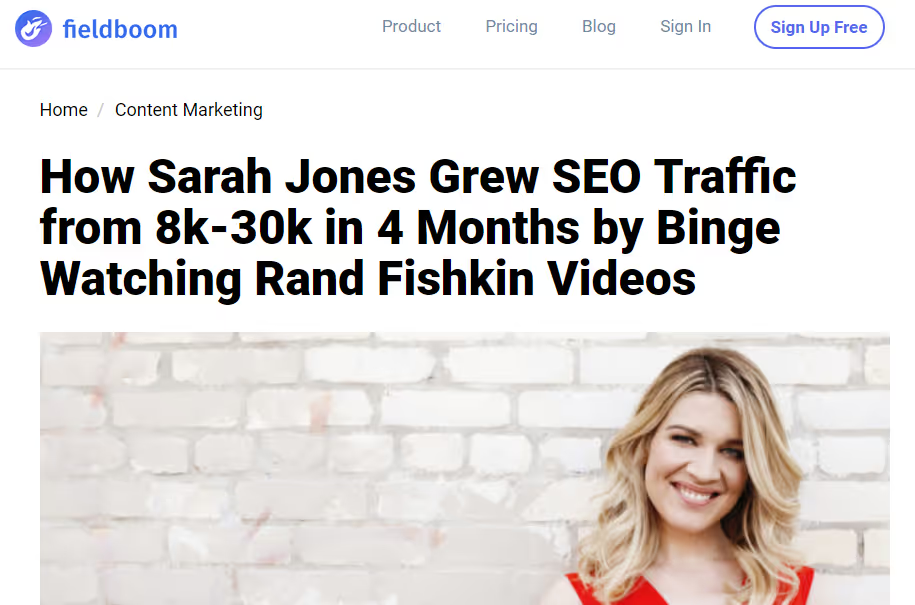
As you can see, the article positions Sarah Jones front-and-center. The result is a thorough and actionable case study that exposes Sarah to a wider audience.
Here’s a simple formula you can use to come up with story-driven articles:
“How [INFLUENCER/BRAND] Grew/Generated/Reduced [PROBLEM] [QUANT] in [TIMEFRAME] by [ACTION]”
Let’s break each element down:
- Influencer/Brand: The individual or organization you’re featuring
- Problem: The challenge they solved or the results they generated
- Quant: Provide specific numbers on the results
- Timeframe: How long did it take them to achieve this?
- Action: How they got those results. This is the topic of the article
From here, you need to create a killer piece of content. Whichever format you choose, it must be actionable and practical.
Take the insights generated from your conversations and provide actionable takeaways for the reader. You’ll learn how to do this in step 4.
Step 3: Influencer Engagement They Can’t Ignore
The most difficult step to influencer engagement is “getting past the noise.”
Here’s the good news:
The methodology outlined in this guide is designed to cut right through it.
Getting an influencer featured in industry and business publications is a sure-fire way to grab their attention.
The best method to reach out will depend on each target influencer. And to make matters worse, once GDPR ruins everything in May this year, you may want to diversify away from email.
Regardless, here’s how to reach out to B2B influencers and begin the relationship.
Pre-Engagement for Familiarity
While not always necessary, you can get on an influencers’ radar before reaching out.
Let’s look at some common methods of building familiarity.
Yes, I’m aware a “poo-pooed” these at the beginning of this guide. But these techniques are designed to nurture, not as a way of pretending to give superficial “value.”
- Comment: If they’re publishing content, add meaningful comments. By meaningful, I mean useful. Don’t just say “Nice post!” Ask questions, add your “two cents” and inspire debate.
- Social Engagement: Respond to their posts on Twitter, Facebook, and LinkedIn. Go beyond “likes” and get involved in the discussion. Tweet at them, comment on their posts and mention their name when sharing their content.
- Communities: Find the forums and groups they’re active in and get involved. You can do this directly or indirectly. Indirectly means contributing to the entire community.
These are just a few easy methods of getting on an influencer’s radar. The underlying principle is a simple one:
Go where your influencers are and start a conversation with them.
Influencer Email Outreach
If you can find the right email address, this form of outreach is often the most effective.
I’m not going to share any templates. They can quickly saturate and ruin an approach. Instead, here’s a framework you can follow to write your own:
- Personalized Opener: The expectations on personalization moved on long ago. “First name” variables no longer count as “personalization.” Instead, reference conversations and content where your paths have crossed.
- Get to the point: State why you’re reaching out, and why it’s relevant to them.
- Take the lead: The responsibility must be on you. Whether you’re guest blogging or creating co-branded content, you should be the one taking care of the heavy lifting. Make this clear to them and working with you will be a no-brainer.
- Soft CTA: Your call-to-action shouldn’t be assumptive or pushy. Simply ask them if they’re interested in collaborating.
[[component]]
If you’re reaching out to executives within an organization, Elucify is a great lookup tool for professional details and email addresses.
Social Engagement
Use the following approaches if you’re unsure of the legal aspects of cold outreach. This is a hurdle will affect many of us thanks to GDPR in 2018 and beyond.
Start with Twitter. Send a DM if your target influencer follows you. Use the same principles laid out for email outreach above.
If they don’t follow you, then you’ll have to tweet @ them. You have less room to make a case here, but 240 characters should be enough.
Get to the point quickly. “Hey @username, I’m writing a piece on TOPIC for PUBLICATION and wanted to get your thoughts on CHALLENGE THEY OVERCAME. Can I DM or email you?”
Alternatively, there’s LinkedIn. When connecting with your target influencer, add a personal note to state the intention. A note will increase the accept rate on your connection requests.
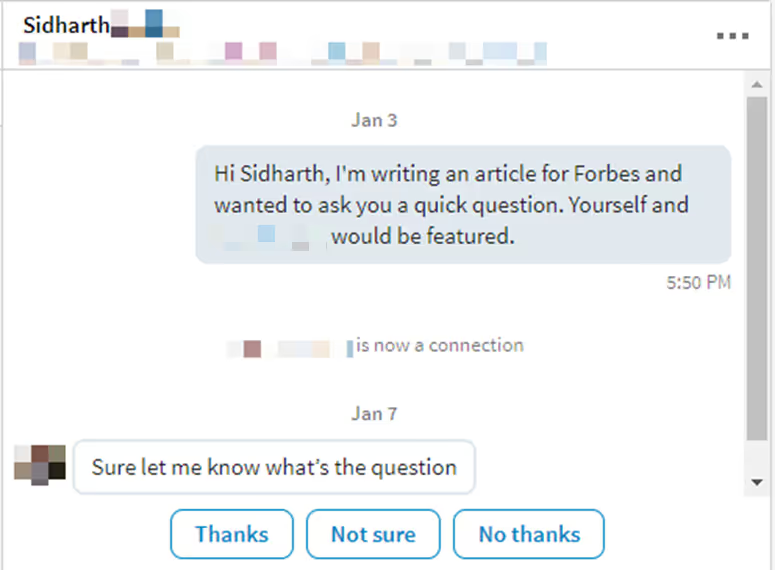
(Details blurred out for privacy)
What if influencers don’t respond? Try again on another channel, and keep following up until you get a “yes” or a “no.” Persistence is key, especially if you believe you’re adding real value.
Step 4: Influencer Interviews For Awesome Insights
So, you’ve established a relationship, and you’re ready to create content or establish a partnership.
Influencer interviews are the final step. Here, you’ll learn how to set up these discussions, the right questions to ask and how to turn their insight into content.
1. Digital Interviews
Some influencers just don’t have the time to chat with you on the phone. Deal with it and interview via digital channels.
I took this approach when creating the CrazyEgg post mentioned earlier. In fact, I conducted an entire interview with Sujan Patel on Twitter:
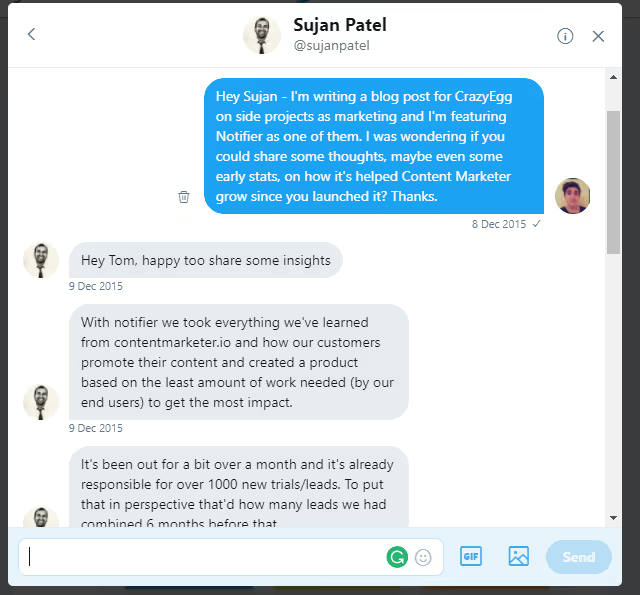
Just like any other interview, you can then dig deeper into their responses to understand the larger impact and thought processes behind these strategies.
Don’t let them drag on too long. Try and limit to three to five exchanges. Otherwise, you’ll see response rates drop.
2. Phone Interviews
Interviewing over the phone is the preferred approach for two reasons:
- You can dig deeper into responses while getting honest, raw insights on their motivations, needs, and experiences.
- It’s much easier to build rapport and lay the foundations for strong, long-term relationships.
When asking influencers for the interview, give them the option to talk on the phone or via email, Twitter, or LinkedIn.
What should you ask them when you have them on the phone? Here’s a framework I’ve borrowed from customer development frameworks.
- Really, really listen: Don’t wait your turn to respond. Instead, soak up everything influencers have to say. Learning to listen will help you use the next principle.
- Be open: Avoid scripts at all costs. Instead, ask questions that probe and dig deep into their answers. Allow yourself to be flexible depending on their response.
- Don’t lead: Avoid questions that imply an answer. E.g. “What impact did your side project have on lead generation?” vs. “How did this side project impact your business?” You’ll get more insights this way.
- Make friends: People do business with people they like. Spend one or two minutes at the beginning of the call to learn more about what they’re up to, but get to the point quickly.
Go in with three or four open-ended questions. Let their responses drive the rest of your questions. Get an understanding of the true impact their experiences and results had in their business or career.
Turning Influencer Insight into Content
You’ve conducted the interviews, and you have pages of notes. It’s time to turn that insight into content.
Your content must be actionable and practical. Whether it’s a guest post, webinar or podcast interview. The reader/listener should be able to execute on what you teach.
A good litmus test is to ask yourself “does this thoroughly guide me through the solution?” If the answer is no, add more detail to your content.
The introduction should outline the challenge, pain or complication in the market. What’s the problem that your content is about to solve?
One way to boost credibility here is to include third party data and statistics. Cite them when backing up your points throughout the entire piece of content.
Influencer insight will allow you to tell a story. What was the challenge, and why was this such a pressing problem for them and their business? How did they overcome these challenges?
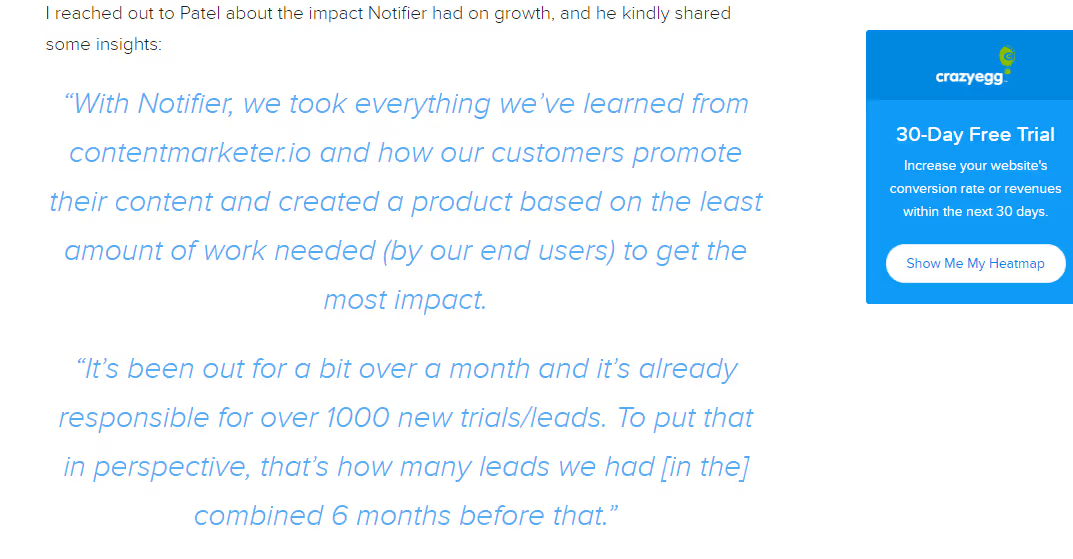
Then, it’s time to drive practical value. Extract takeaway lessons from your influencer’s story. Provide actionable steps with examples, screenshots, and instructions on how your audience can do the same.
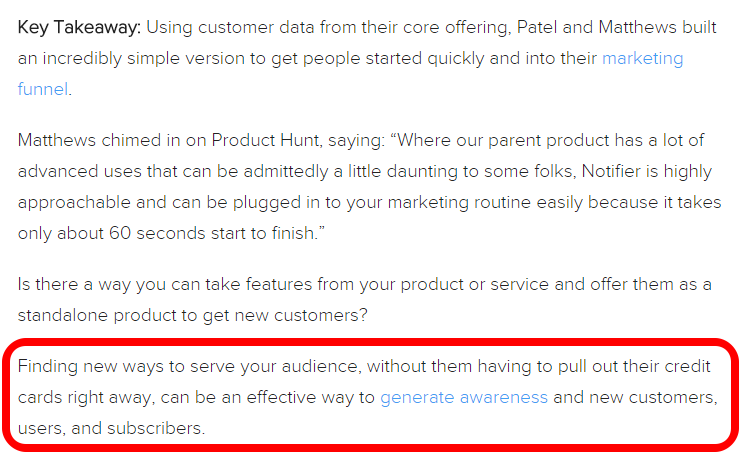
Include as many quotes, statistics, examples, and images as possible. These ramp up the perceived value of your content, leading to more shares, traffic and, most importantly, leads.
Conclusion
This methodology is designed to work across all platforms and content formats.
Looking for interview opportunities on podcasts? Need examples for an upcoming webinar? Influencer interviews will help with that.
The importance is that you’re adding value to all three parties:
- The creators or editors for the platform/publication your content will feature in
- The influencer you’re engaging with
- You and your business
Drive as much value to all three, and you’ll see your audience expand rapidly.


Your content brief is the roadmap that paves the way for high-quality content.
Without a solid brief, you’re likely to produce content that fails to meet expectations. A good brief connects your strategy and traffic goals with expertise and audience needs.
After collaborating with dozens of clients, content marketers, and writers, we’ve found the best approach to removing production headaches is a strong angle, detailed outline, and collaboration at the brief stage.
Your audience, why this topic matters to them, and how you’ll inject your expertise should be crystal clear for every stakeholder.
This article will detail the process and components of a content brief that drives high performing blog posts, landing pages, and more.
Content positioning
Content marketing is suffering from a case of “blind leading the blind.” For SEO-driven content, research often starts and ends by reverse engineering the SERPs.
Reverse engineering Google is critical for search. However, it will hurt your credibility if used as your only research method. Copying other articles “because they rank” is symptomatic of a lack of subject matter expertise. Your buyers can smell it a mile off.
Solid research is the bedrock of a great content brief. Conducting SME interviews, taking inventory of your own experiences, and diving into the rabbit hole of a topic is critical when writing for skeptical and experienced audiences.
But let’s assume you’ve acquired this expertise and done your research. It’s time to create a content brief, but where to start?
There are two key steps that must be followed when beginning the content brief creation process:
- Analyzing the competition to see what they’re doing right, what they get wrong, and gaps they’re leaving open.
- Establishing a unique angle that will ensure your content stands out—no matter which channel you prioritize it for.
These two elements are the most effective ingredients to establish a strong position in the market. One will give you the data to make creative decisions, while the other will help you stand out.
This is what we call “content positioning.”
Content positioning means treating your content like a product, differentiating it in a competitive marketplace, and helping your ICP solve their jobs-to-be-done (JTBD).
How to find an angle that outperforms the competition
Content positioning requires an understanding of the value other articles are offering and how they’re currently getting attention.
To identify competitive gaps, you must first understand what you’re up against. There are three approaches to competitive content analysis:
- Content quality: What’s the overall quality of other articles? Do they lack value? Are they repeating the same conventionally held (yet incorrect) beliefs as everyone else? It’s often possible to outcompete on quality alone or by focusing on a hub-and-spoke strategy to build topical authority.
- Brand equity: Are you up against a number of industry incumbents? Do they have a monopoly on the topic, or are they dipping their toes in? This is a reality that should inform your overall content strategy, not just your brief. For example, a project management brand like Asana writing a one-off article on “remote working” is unlikely to have much authority on the topic.
- Distribution landscape: For SEO-driven content, how hard would it be to rank based on the number of backlinks other articles have earned? What’s the keyword difficulty for your primary term (as well as the average across your entire keyword cluster)?
Your findings will inform how you approach the production and distribution of your content. For example, you may find a top competing article from a startup has lots of backlinks, but is poorly written and contains little utility. This is a prime opportunity to outcompete by creating more authoritative and value-driven content.
Competitive analysis will help you inform your content positioning and create original blog articles. Here are three practical ways to apply your findings:
1. Finding unique angles for search
Too many content marketers continue to create content by reverse-engineering and emulating the SERPs. But this presents a deeper issue, as content begins to look the same and, over time, erodes the user experience.
While aligning content with search intent is critical for organic growth, it mustn't be followed blindly. Use the SERPs to evaluate competing content and identify gaps that you can fill.
For example, when writing an article on CRM technology, you might find that nobody covers how to evaluate and choose the right platform. Instead, everyone focuses on definitions, benefits, features, and the like.
In this scenario, you could include an entire section that teaches readers a process for evaluating CRM vendors. This creates a temporary moat around your content and provides the reader with more value in the form of practical next steps in their vendor research.
2. Communicating credibility and authority
Marketers often make lofty claims with no data or proof to back them up. This provides you with an opportunity to build a more credible and original piece of content.
Building authority is more than writing in the language of your audience. It means collecting or leveraging experience and expertise on a topic.
For example, if you’re writing for a senior marketing audience on ICP research, you’d ideally seek input from an expert that has experience conducting countless customer interviews.
Using your audience’s language will generate more engagement. But to build trust, don't just emulate their words, speak their mind. Reflect back what they're thinking but nobody else is saying out loud. This will build deeper emotional resonance and connections. These insights can only be gleaned from someone your reader would consider a peer.
3. Be controversial
In marketing, zigging while everyone is zagging can be all you need to differentiate yourself.
Rand Fishkin, founder of SparkToro, did this when a customer asked for advice on cold outreach. After searching Google, he found the SERPs contained repetitive and outdated advice:
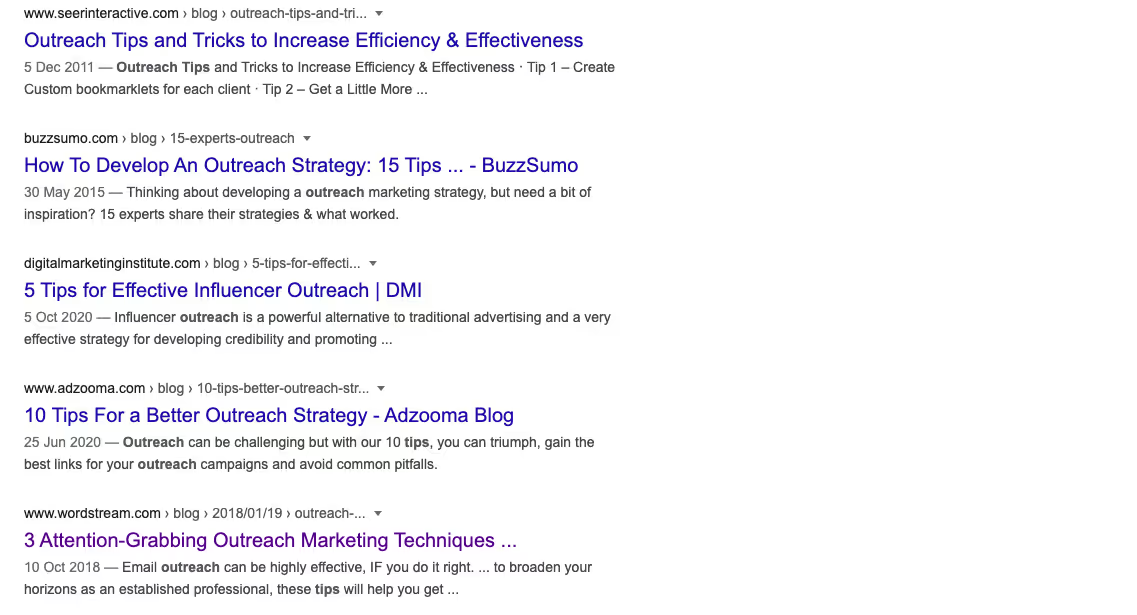
So he decided to write an article on the topic to call out these outdated practices, titled “Outreach Tips (better than anything you’ll find searching Google):”
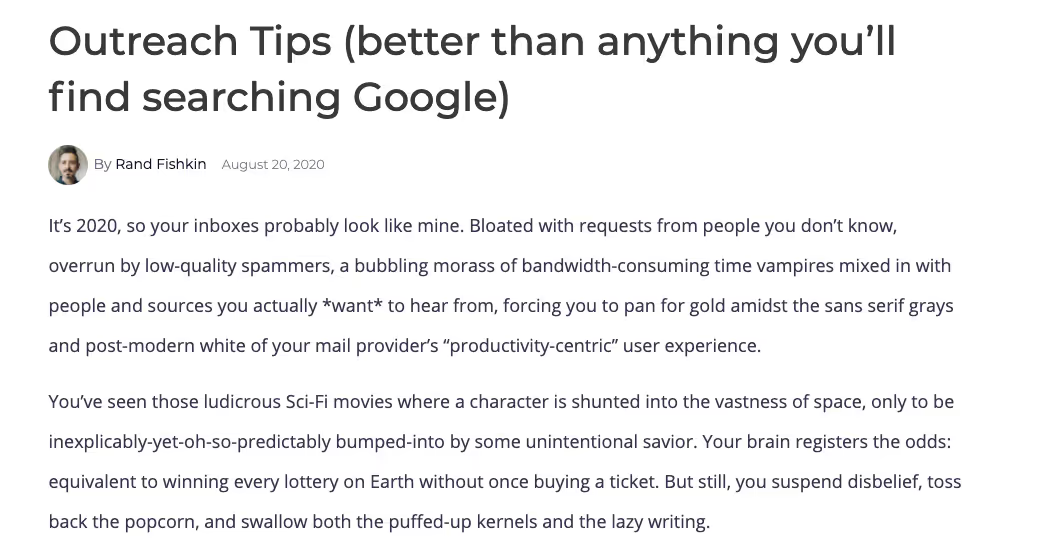
He opens up with a controversial introduction before moving on to a subsection that promises the reader eight tips they won’t find anywhere else.
This article is one of the most commented on the SparkToro blog and ranks below the featured snippet for the term “outreach tips:”
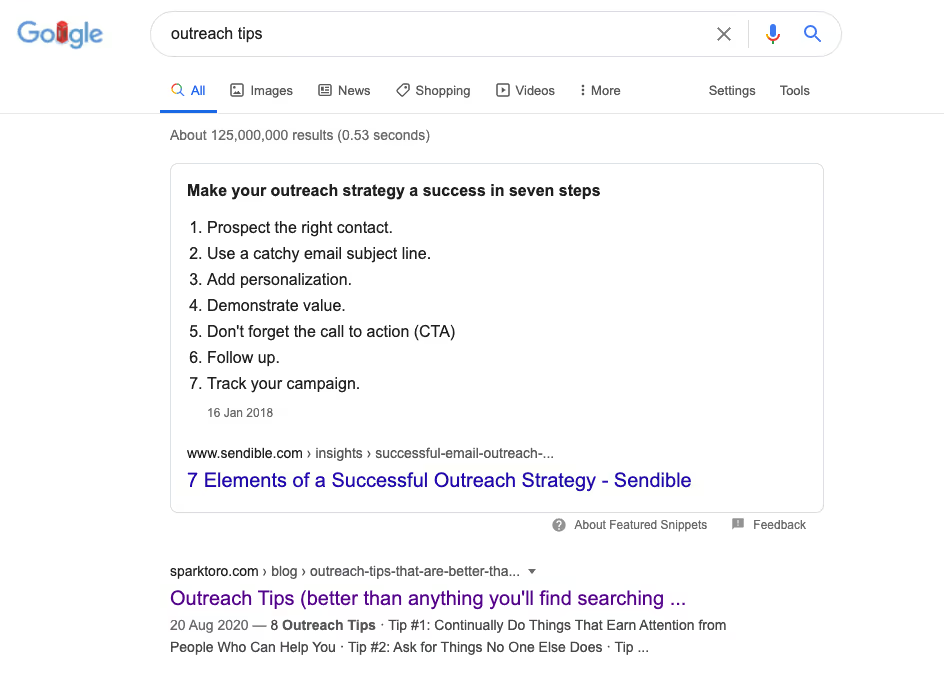
[[component]]
When a seasoned marketer or salesperson next searches for cold outreach tips, which result do you think will stand out in the SERPs? We’d hazard a guess that Rand’s article gets the lion's share of clicks.
A controversial angle breaks the mold and grabs attention in a sea of sameness. Allow your content to stand out by framing it around earned, accurate, and proven advice.
Building an outline using data & creativity
A good outline creates context around your content and communicates the narrative to other stakeholders involved in the production process.
Including a clear objective will keep everyone aligned on outcomes and avoid the problem of “too many cooks in the kitchen.”
Let’s say you’re a SaaS startup and your primary goal is “generating organic traffic with high buying intent.” In this scenario, your article should sit within the sweet-spot of these three areas:
- Algorithm: What themes, questions, and sections has Google deemed important for the user to fulfill search intent?
- Audience: What are your customers hungry for and what gaps are competitors leaving unfulfilled?
- Product: How will your content align with your value proposition, solution, or product?
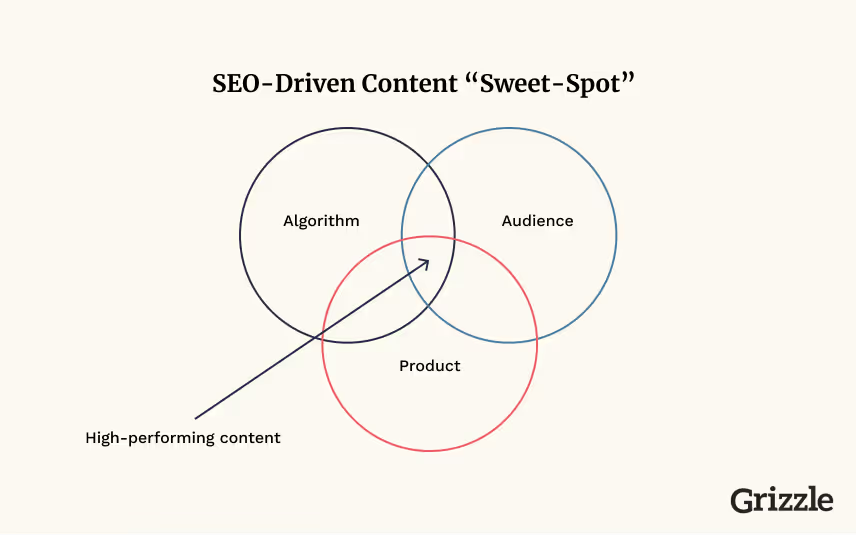
Templates and frameworks can guide you through the production process and reduce the friction in getting started.
For example, a “how-to guide” template follows a step-by-step instructional narrative, which is perfect for anyone targeting individual contributors looking to solve a problem or JTBD.
Alternatively, when targeting senior decision makers, you might use a framework that outlines their problem, builds an argument for new solutions, and demonstrates a new way of doing things.
Use tools like Clearscope when planning SEO-driven content to uncover which themes to include. Here’s what some of those relevant terms look like for the term “DOOH” (digital out-of-home media):

Avoid stuffing these terms without context, as you’ll ruin the content experience and undermine trust. Use this data to inform sections and themes to include in your content.
Finally, don’t worry about perfecting the subheading copy. Subheadings should simply communicate what each section will cover. Once you’re writing the draft, your subheadings should communicate the benefits or outcome that each section promises to deliver. This grabs the attention of skimmers and communicates the overall value of your content.
Outline collaboration
Everyone has their own method of writing outlines. Instead of providing you with a rigid framework, here’s a scrappy example using the DOOH topic introduced above:

Here, we see a portion of the outline that includes details to add context around what each section will include:
- Outcomes that the target audience will benefit from using DOOH
- Statistics and data to back up certain claims
- Key DOOH metrics to measure, what they mean, and why they’re important
Your outline also provides a canvas for stakeholders to get involved. Including lots of white space and nested bullets will create a hierarchy that’s easy for everyone to follow. Stakeholders can add comments with their thoughts and insights with ease.
Collaborating on an outline will mean fewer draft revisions as the narrative and structure was agreed upon well in advance.
Content briefs are your roadmap
Many marketers see the brief as a hurdle to overcome between having an idea and writing it down.
Your content brief is the compass and your outline is the roadmap. Both allow you to find a gap in the content landscape and uncover an angle that your audience is hungry for and will stand out.
Point in the direction you want to go in, chart a course, and pave the way for content that resonates with your audience.


In this article, we’ll outline the content-driven acquisition methodology we use to help companies get results like this:
- Fintech company: Avg. ~5,000 leads generated each month using a content-driven paid media strategy (over a 6-month period)
- MarTech company: Avg. 47% conversion rate from content
- Consulting company: Avg. 42 marketing qualified leads (MQLs) a month
🤫 We’ve included anonymized data throughout this article. Want to learn more about what goes on behind the scenes? Get in touch.
What is Content-Driven Acquisition
Content-driven acquisition is the process of taking marketing channels like Facebook Ads and using value-driven content as the centerpiece of those campaigns.
It’s an approach that utilizes blog posts, lead magnets and other content assets to attract new users and expand your audience. While some may not be ready to buy from you now, you can educate and nurture them into customers over the long term.
It’s great for ecommerce, DTC and consumer tech brands looking to build an audience, as well as B2B and SaaS organisations with lengthy sales cycles that rely on lead generation.
Blending paid & organic acquisition channels
Using content to fuel your paid media efforts can help you:
- Diversify and expand your target audience/visibility
- Generate better long-term results (traffic, conversions and brand building)
If you’re looking to raise funding, it can also help you control your growth narrative. Do this by showing investors you’ve built an active and engaged community.
We’ve seen our partners use content to generate traffic at a lower CPC (and CPA). It also helps us to generate a burst of short-term traffic while invigorating long-term growth.
In other words, you can play the short- and long-term game with every content asset you produce.
Test on a small scale with a portion of your ad budget. Measure the results at all stages of the funnel (subscribers, leads, sign-ups and purchases). If the results are favorable, allocate a higher budget to scale.
This requires you to have a full understanding of your audience and customer journey:
- Without proper targeting, you’ll end up wasting money on unqualified traffic
- Without an understanding of the customer journey, you risk losing sight of the true, long-term ROI
For example, if you’re a DTC brand, you may find subscribers don’t necessarily convert immediately. But they may, on average, make their first purchase in 30 days.
Use long-term thinking as a way to accurately calculate and forecast ROI. The way you segment audiences into cohorts is up to you. Make sure your content efforts are getting the attribution they deserve.
Optimizing content for conversions
You may be creating epic content, but what happens during and after engagement? Are you optimizing your offers and calls-to-action to capitalize on this attention?
For example, readers of a how-to guide might simply want more information to help overcome a specific challenge. Therefore, creating a lead magnet that covers the topic in more depth is likely to drive action.
Conversely, you can include more commercially-driven offers if the topic is related to your product. For example, a coffee subscription brand writes a piece on the health benefits of coffee. They could include a call-to-action to sign up for a subscription at the end of the article.
Generating conversions from your content requires an understanding of the following:
- Context: Why are people reading your content? What are they motivated by? Help them take the next step in this journey by offering the right information or products.
- Experience: Don’t include calls-to-action that ruin the experience. For example, pop-ups that interrupt the reading experience can frustrate some readers.
People are more critical of content these days. Information is abundant, and if you get in their way, they’ll happily look elsewhere.
Using email marketing to educate & nurture
As you generate subscribers and leads, you’ll need to nurture them. This can be done through education, additional content and product offerings.
Your email marketing strategy will vary based on the nature and complexity of your product. Two of the most common formats are:
- Email newsletters: Regular digests containing content and product offers
- Nurture sequences: Automated emails sent over time that are designed to educate the audience on your brand and product
Many marketers use a blend of both. For example, SaaS companies often use email sequences for lead nurturing and product onboarding. I’ve also seen DTC brands use automated emails to introduce their brand before sending scheduled monthly newsletters.
Your emails must guide prospects and customers through the customer journey and give them the content they need, when they need it.
Conclusion
Content-driven acquisition caters to all stages of the customer journey. Each touch-point is designed to educate and empower your audience.
Fostering this approach can be as simple as using content to fuel your existing paid media efforts.
You won’t know until you speak to your customers. It’s the insight they give you that should fuel your content efforts. Listen, and then produce the content they need.
Many brands reach a stage where they no longer wish to rely on paid ads and performance marketing alone. Transitioning to organic acquisition is an attractive prospect.


B2B marketers must make their account-based content programs relevant. The best way to do this is to become disciplined with customer conversations..
Here, we’ll share an account-based content playbook that accelerates enterprise sales pipeline. You’ll learn how to attract the c-suite, sell to entire buying committees, and cross-sell into new markets through customer expansion.
Converting customer success into content
“Where do you go for new information?” is a common question we ask in our customer interviews.
After countless conversations with senior decision-makers in dozens of industries, we’ve found that most leaders look to their network.
Specifically, they rely on:
- Their direct reports: Both individual contributors (ICs) and middle-management
- Their peers: Commonly those with the same job role in other organizations
This is why customer success content works so well.
It elevates peer experiences and places them in front of your ICP. Goodwill is created within target accounts while proving you can get results.
The approach is even more effective when applied to customer expansion. Not only have you proven your success within an organization, but you’ve already overcome the red tape to become an approved vendor.
But doing this right means making your customer the hero of the story. Here’s how:
Write about shared pain points
Pain points are rarely unique to the individual, no matter what many may think. However, this belief is often a good indicator of problems that buyers are desperate to overcome.
By conducting customer interviews, you can identify these pain points and start to uncover patterns.
Prepare for interviews with account stakeholders and c-suite execs by limiting yourself to a set of broad questions. This allows you to follow “conversational threads,” using follow-up questions to dig deeper into their responses.
For example, the question "what are your revenue goals for the next six months?" may be met with the following response:
“We're looking to develop new revenue streams to improve customer value and improve the product experience to reduce churn.”
This response gives us two conversational threads to follow: “new revenue streams” and “product experience optimization.” But we don’t yet have context as to why and how they’re doing these things.
We can elicit this context using questions like:
- What do these new revenue streams look like?
- Why is improving the product experience important?
- What are the biggest hurdles you face when improving the product?
The answer to these questions may seem obvious, but they allow you to uncover the language customers use and identify new conversational threads to go deeper. It helps you reveal more context, the motivations behind their goals, and the root cause behind the pain point.
Let’s say you’re targeting VP-level marketers working at enterprise software companies. A common problem associated with improving the product experience might be:
“We want to ensure customers are getting as much value from our product as soon as possible. ‘Time to value’ is an important metric to us because we want to drive adoption across all teams within customer accounts.”
We now know the following:
- “Time to value” is an important metric
- This means customers get as much value as quickly as possible from the product
- Why is it important? Because it’s correlated with greater account value as more users adopt the product
Individual contributors have their finger on the pulse of these challenges. Make time to speak with both senior decision-makers and ICs to understand how a problem impacts the entire organization.
Cater to the buying committee
The sales cycle is more than a series of calls and consultations. It may start that way during discovery—where one or two stakeholders lead the conversation—but behind the scenes you have their bosses, CFOs, and procurement teams to convince.
Trouble is, you don’t have direct access to these people, and therefore cannot directly influence their decisions.
Account-based content helps overcome this bureaucratic maze. It acknowledges that the needs of stakeholders beyondt your immediate buyer must be catered to.
What content should you create for buying committees? Start with the following ideation process:
- Customer interviews: Again, ask questions about what the buying and procurement process looks like for your customers.
- Sales teams: Work with sales leaders to collect insights. Arm your reps with the right questions and communicate how it fuels material that will help them close more deals.
- CRM data: Segment your best accounts and review contact history. Which contacts were involved early on in the sales process? Are there any insights that can be gleaned from sales activity and notes left by reps?
Turn these insights into decks, short-form articles, slides, and even video content. Tools like Loxo allow you to create microsites for each account, organizing content in a personalized manner that makes it easy for your prospect champions to get internal buy-in.
Empower individual contributors to influence upwards
Alongside peer recommendations, senior decision-makers look to their direct reports for insights from “the field.” These include new ways of working, vendors, and content that aligns with internal conversations.
Top-of-funnel content still has a place at the table. ICs and middle-managers help senior decision-makers filter through the noise and have bottom-up influence in an organization.
Here’s how to write for ICs:
- Position content around daily tasks and priorities: While ICs rarely have buying power, they are your end user. Providing actionable content around specific use cases will arm them with a solution to present to their managers.
- Integrate organization-wide challenges: Some problems run so deep they frustrate entire teams. Write about these to create internal buzz.
- Focus on the big problem early on: Don’t keep strategic pain points hidden halfway through an article. Use article and section introductions to make it clear your audience is in the right place.
When writing for ICs, make them think “I need this, and so does my boss.” Teaching them how to solve a JTBD can act as a trojan horse.
For example, message testing platform Wynter’s ICP is VP-level demand generation and product marketing leaders, but this article on message testing caters to a beginner audience:

It ranks for the primary target keyword because it caters to a beginner audience. ICs are looking for information on the topic because they want to learn what it is, how to do it, and examples of it in action. The same goes for VP-level audiences who have yet to discover what message testing is.
Creating content for both buying committees and ICs alike gives you a diversified content portfolio. In the account-based marketing world, it pays to cater to all seniorities.
Create episodic content
Episodic content applies various topic ideas and formats around a central theme.
In a recent episode of the Demandist podcast, Nitsan Peled, Director of Content at Optimove, shares how he takes an episodic approach to account-based content:
“We took from Netflix’s book. So if [for example] we want to talk about segmentation, we come up with a series with a title or topic. And then we break it down into chapters. And we find someone to write those chapters.
“We come up with seven episodes. [Each] episode would be dedicated to a specific brand.”
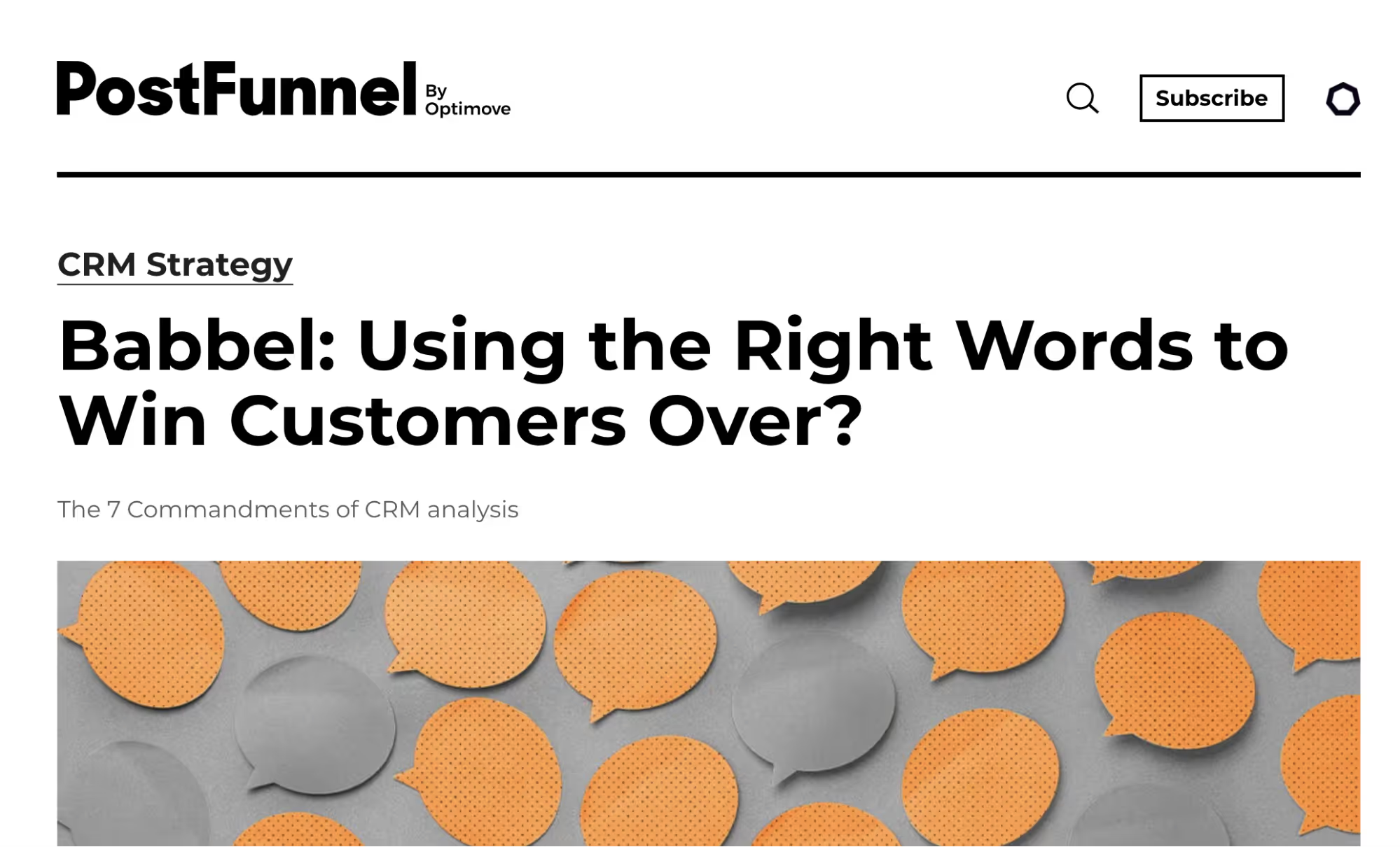
This approach allows you to:
- Demonstrate you understand the world your customer operates (think subject matter expertise and industry challenges)
- Share the success you’ve already delivered to customers and other departments within existing accounts (for your customer expansion efforts)
- Provide actionable insights and guidance for ICs across an organization
Dedicating a content series to a single industry, job role, or JTBD can seem like a mammoth task. However, the concentrated attention it yields can have a compounding effect on pipeline and awareness—especially when attracting a narrow audience.
Account-based content distribution
Getting your content seen by target accounts requires a personalized approach to distribution.
To capture your ICP’s attention, you must go beyond traditional promotion tactics like content repurposing and email newsletters.
1. Empower your existing customers
Your customers are your biggest advocates. Getting them involved in the entire content production process not only highlights success, but primes them to share it.
They’ll also give you insights into how other areas of the business operate, which is crucial for customer expansion.
Once you’ve injected customer stories into your content (as well as any direct quotes from users), give them the tools they need to amplify it. Provide them with guidance and ease objections with a plan that they’re comfortable with.
Here’s how your customers can help with distribution activity:
- Repurpose for social: Make the sharing process easier for them by writing LinkedIn posts on their behalf. Get them on a call, ask them a question about the topic, and then repurpose the recording into short-form video content.
- Reach out to internal influencers: Identify contacts within existing accounts. Gauge whether it’s appropriate to reach out and share that content directly.
- Share on internal channels: There may be an employee forum or community where cross-department conversations take place. Uncover this during the early stages of the process, and only suggest it if your customer feels it’s appropriate.
For customer expansion efforts, you must also uncover:
- The cultural barriers you must overcome
- How buying committees work in different geos
- Whether or not they share the same pain points
The world is getting smaller from a communications perspective, and many of these factors may no longer apply (especially when marketing to millennials). However, do your due diligence to ensure your messaging is appropriate.
2. Create an employee advocacy system
Speak to your salespeople and identify target account contacts they’re engaged with. Involve reps during the earlier stages of the production process. Encourage them to participate during the topic ideation stage.
Uncover the objections they experienced when closing customer accounts. Use this to fuel social content that acts as an idea barometer. The more engagement a post gets, the more likely it is that a long-form article will perform well.
Coordinate with reps and keep them up to date with your publishing schedules. Encourage them to share your content directly with their prospects and amplify it on channels like LinkedIn.
3. Repurpose for social
Double-down on your employee advocacy and customer success efforts by creating a series of social posts for your company page.
Yes, we all know personal profiles (anecdotally) generate more engagement than company pages. But this is only true because brands don’t push the envelope and give their brand a personality worth following.
Just look at Lavender as an example, which has amassed over 26,000 followers in a matter of months due to their fun and educational content:
To extend your reach and get the attention of other account employees, tag them in your post. But only do this if they’re involved in the content itself.
Repurpose your how-to articles into a series of posts that dive into specific elements. Highlight relevant pain points and dig deep into specific challenges. Don’t forget to cater to both senior decision-makers and ICs.
4. Guest case studies
Repurposing your success stories into guest posts can quickly get your message in front of a wider audience.
It’s also a great incentive for getting customers involved. Speak to several contacts to learn which publications they read and which are most popular.
Secure placements by reaching out to editors and pitching topics that sit in the sweet spot of these three areas:
- What the publication is hungry for: Look at recently published articles. Reverse engineer the highest performers (think social shares) to find top performing formats.
- Conversations happening in the market: Tie your customer success stories to pain points experienced by the rest of the market.
- The problem your product solves: Focus on a relevant pain point that a specific product feature solves.
Checking all three boxes ensures your guest post will get accepted. Have your cake and eat it too by writing about themes close to your product and ICP challenges.
Land and expand
Individual contributors, junior executives, and director-level leaders are all working towards the same goal.
Your content should serve everyone involved in achieving it. Make your account-based content work harder for you by writing for everyone with skin in the game.
You can’t always do this with a single piece of content without diluting your message. However, with a well-coordinated plan of attack, you can work all ends of the chain and get the entire department’s attention.
Establish authority and expand your customer accounts by getting the whole team talking about you.


In this article, we’ll show you an agile video production process to help you build and scale your media marketing efforts.
Aligning video content with marketing objectives
The purpose of video marketing is to support demand generation and user acquisition. Done right, video content inspires action while contributing to a delightful user journey.
For example, here’s how video might contribute to different stages of a product-led user journey for digital PR software:
- Awareness: An agency founder (a segment of the digital PR brand’s ICP) watches a social media video created by an employee that talks about the importance of building journalist relationships. They then watch a long-form YouTube video on setting up outreach systems for clients.
- Acquisition: The agency founder visits the brand’s website and navigates to the agency use case page. They watch a video that dives into how specific features apply to their needs and sign up for a free trial.
- Activation: Thanks to proper segmentation, the agency founder—now on a free plan—receives a tailored onboarding experience and product video. It shows them how to get started using features that will help them kick off outreach for a single client.
- Retention: The user receives an invite to a webinar that dives deeper into how to use the product across their entire client base, including managing multiple inboxes and personalizing outreach for several audiences. The agency founder requests their team to attend and come up with action points.
- Revenue: Thanks to segmented email workflows and an increased number of users across the account, the agency founder enters their credit card details after they hit usage limits.
Here, video allows the digital PR brand to make a bigger impact by hooking their audience and nurturing segments to conversion as they proceed through the user journey. The formats vary, but each video has a specific purpose.
Drift uses similar tactics to attract and funnel potential users into its pipeline. They use simple animation and motion graphics to produce product marketing videos that educate users on their products:
Drift’s marketing team has also built a library of webinars that dive into new trends and marketing approaches:
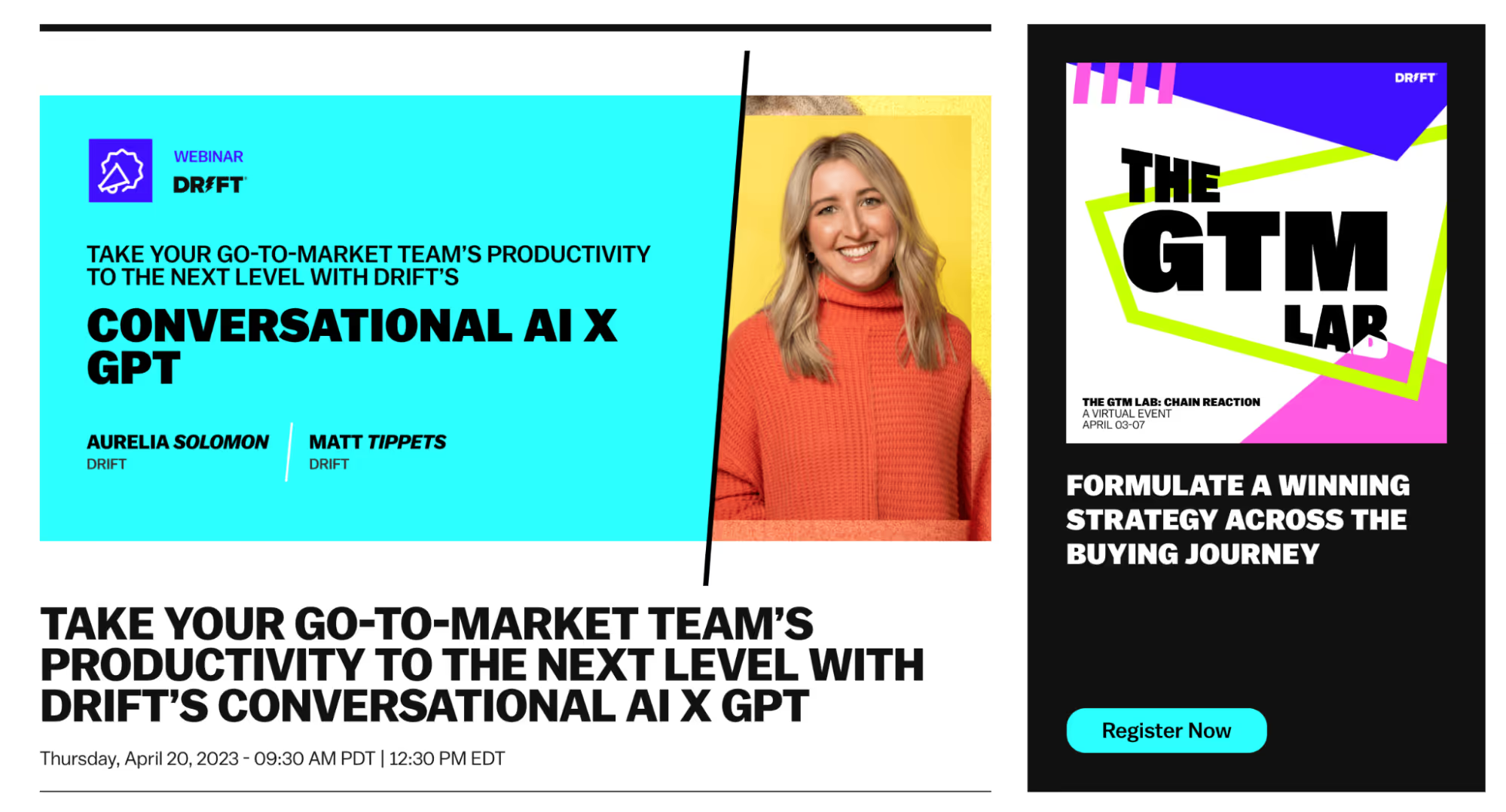
This, on top of their library of blog articles, ebooks, and reports, helps position Drift as an educational media brand. The library of content they’ve built attracts an audience looking for solutions to relevant challenges.
Drift has a blog full of high-value content, and it utilizes strong copywriting across landing pages and product experience. Investing in video provides new methods to deliver value and cater to their users’ consumption habits.
Later follows a similar blueprint, going all-in on video with its Instagram training videos. Video is used as a platform for:
- Collaboration: Later partners with social media experts to present and share their experiences. This gives Later’s audience more value while tapping into a wider audience.
- Positioning: Later doesn’t offer “just another webinar.” You’re enrolling in an in-depth course that will help you achieve a specific result for your business.
- Design: Landing pages communicate huge amounts of value and look visually stunning:
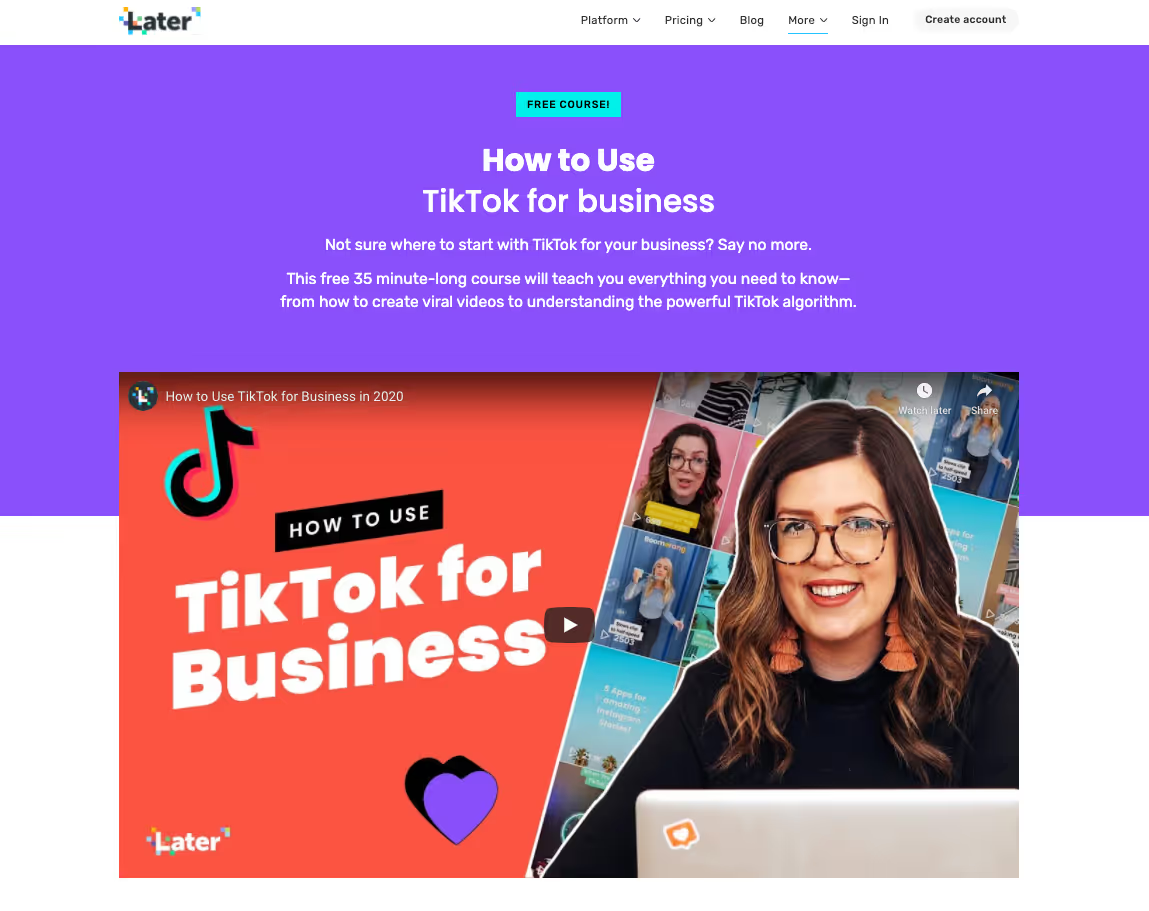
Video content and employee advocacy help position Later as a trusted authority. Empowering Later’s roster of experts helps them build a personal connection with users at scale.
Take stock of the channels and marketing strategies you’re already investing in. Find ways to deliver more delightful experiences by adding video into the mix.
A video production workflow that scales with ease
Many marketers assume video marketing involves lengthy lead times and large production teams.
This is mainly due to how many traditional production agencies still use old school playbooks. Dozens of middle-men have a stake in the creative process. Not only does this bloat production timelines, but it’s also incredibly expensive.
By the time a creative brief has reached the talent needed to produce that content (such as videographers and animators), most of the budget has already been used up.
For us marketers, this amount of bloat is unacceptable. Simplifying the process is critical in order to scale efficiently and get it all done within budget.
Once we boil the video production process down to its core 11 components, it starts to look far more manageable. These components are:
- Pre-visualization: Marrying content strategy and visual research, this stage involves gathering reference materials from sources like YouTube, Pinterest, and Instagram—as well as other films, animations, and aspirational video content.
- Script: An important step to streamline the rest of the process, your script communicates the content, flow of information, tone of voice, and supporting visual cues (motion design, visual motifs, etc.). Good scripts define the narrative and how you’ll communicate your message while keeping viewers hooked.
- Storyboarding: Each “panel” of your storyboard communicates visual elements, content, imagery, and the layout for your video content. Most importantly, it allows all stakeholders to agree on the video’s direction to reduce expensive and time-consuming revisions later on in the process.
- Music production and voiceover: Sourcing background tracks (known as the “music bed”) and voiceover talent early on will aid editors, animators, and motion designers throughout the process. It informs the flow, pacing, and overall “vibe” of your video.
- Animatics and skeleton edits: This is where imagery, audio, and stock footage are used as placeholders for the final edit. This allows editors to build pieces of the final product as new videography and animation assets are delivered.
- Shoot day: Coordinate videographers, locations, and any direct-to-camera talent (unless someone from your team will step in front of the lens). Batching shoots for several videos at once helps to accelerate the production process.
- Editing: Footage, motion graphics, and animation is gathered and crafted into a finished narrative. For some projects, this process will be ongoing from stage three onwards.
- Colour Grading: The process of balancing and altering colors to capture a specific look and feel. This includes raising lighting levels in darker scenes.
- Visual effects (VFX): Can include simple environment alterations (replacing clouds shot on set with a bright, sunny sky), stylized sparkles from a magic wand, or complex set replacements (actors shot on green and blue screens).
- Animation & motion graphics: These two are used interchangeably and can be added to live video or used as a storytelling vehicle for the entire video.
- Rendering: The final product is signed off, rendered, and exported. Your video must be rendered in the right format for the purpose and platform you intend to use it on.
Great video content used to require dozens of directors, producers, and creatives. But the workflow outlined above is lean and simplified, speeding up the production process end-to-end. It removes unnecessary expenses, all while ensuring the final product is perfect.
Much of this process can be done once and replicated with templates. For example, coming up with motion graphic elements that can be reused in the same way across dozens of social media videos.
Another point of friction when producing video content is the fear of stepping in front of the camera. As Vidyard says, it’s a lot less scary when you’re not making it up as you go along:
“If you’re planning to record yourself, set aside a little time to determine what your message is. Plan out your main talking points. Make some notes.
“If you’re going to be in a scripted video production, ask to see the script in advance to review and get to know your lines
“Regardless of the situation, it’s always going to be easier when you know what you want to say.”
Preparing a script will help you feel more confident when standing in front of the camera. It also allows you to produce a tighter and more compelling message.
Detailed brand guidelines make this process even smoother. For example, Shopify’s brand style guide includes several detailed breakdowns of visual elements:
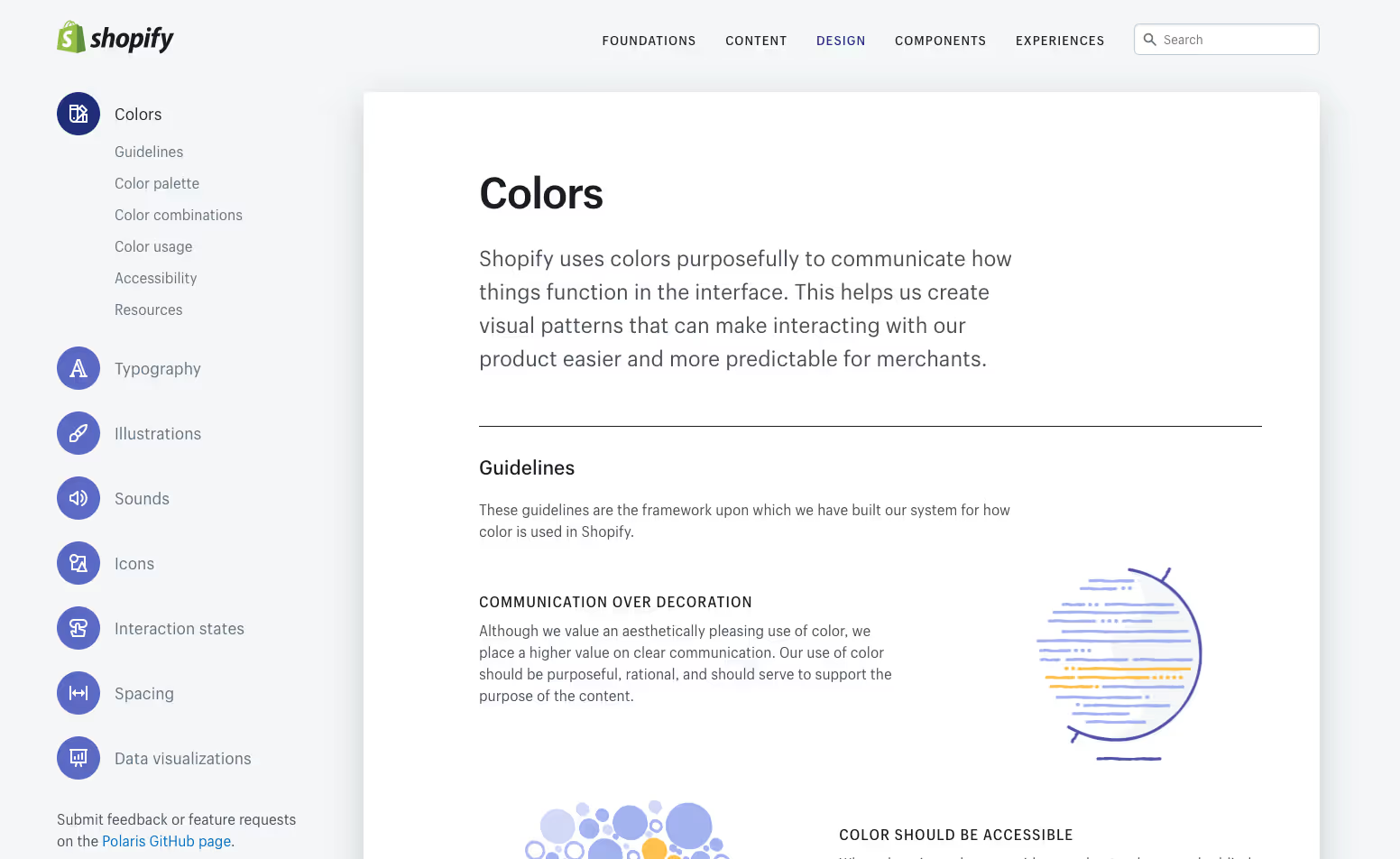
Typography, color, iconography, and even interaction states (e.g. how button colors change between clicks) have been given careful consideration.
Brand guidelines allow Shopify’s team of creators to produce beautiful experiences without dozens of unnecessary and frustrating revisions.
While creating video content may seem like a daunting process, it becomes far easier after the first project. Start with a pilot to get your production house in order. Document the process and standardize elements into a visual style for your brand guidelines.
For example, when we begin working with new video marketing clients at Grizzle, we only commit to a single project in the first month. Once completed, assets are standardized and templated. This allows us to scale to eight video projects a month (and many more when repurposing for short-form video).
Imagine having a single video operation that serves all divisions of marketing and sales from one place. Over time, it becomes easier to test new ideas—without needing a six-figure budget for a single campaign.
Sourcing video talent
The workflow above exists to make life as easy as possible for all parties. But you still need the right people with the right skills to bring your projects to life.
If you’ve collected plenty of reference material, then a good videographer, motion designer, or animator can remove the need for a creative director.
The same goes for production crews. By boiling the process down to critical stages, you only need a single project manager or producer.
At a minimum, these are the people you need to take a video from idea to output:
- Videographer: Takes care of preparing the location, prepping your team or on-screen talent, and supplying filming and lighting equipment on site.
- Motion designer: Adds visual elements to your video content.
- Animator: Produces animated video from start to finish (or animated elements for live action).
- Editor: Takes the raw materials of your video and organizes it into a narrative based on your script. Good editors will obsess over timing to make sure your content is engaging.
- Producer or project manager: Sources and coordinates the right talent, locations, and assets. Ensures projects are kept on track and in scope.
- Content strategist: An in-house marketer or agency to take ownership of video ideation, premise, and promotion activity.
Batch stages of the process together. If you commit to a particular format or framework (and use a script and set processes), you can produce several video assets at once. This will reduce costs while allowing you to scale for a faster turnaround.
For example, if you’re aiming to create four long-form YouTube videos a month, shoot the live-action portion in one day.
When looking for talent, use job boards like Upwork, LinkedIn, and YunoJuno. You can also find specialists on websites like Soho Editors and The Voice Over Network.
Finally, take a leaf out of Wistia’s book and attract a crew that believes in your vision:
“Ideally, you should aim to hire a director, director of photography, sound producer, and gaffer (i.e., lighting technician and head electrician) who are all aligned with your creative vision and direction; any arguing or push-back will be a big time-suck once you’re on set.”
Streamline processes with video frameworks
Like any marketing activity, a proven framework helps you get started with less friction. You can then “break the mold” and test new and creative formats as you grow.
These frameworks provide you with the building blocks needed to share a narrative that keeps viewers engaged.
It’s easy for your audience to click away on the next shiny thumbnail they see. Your job is to keep their attention while adding as much value as possible.
Luckily, there are frameworks that work for every objective and video format. Here are four frameworks used among product-led brands:
1. Explainer videos
Explainer videos are typically used to communicate the benefits, features, and problems your product solves.
High-quality animation and motion graphics are key, as they allow for engaging and entertaining storytelling while keeping your customers wanting to learn more about your product.
But there’s a trap many fall into when writing explainer video scripts: focusing too much on outlining well-known problems.
Users are smart. They can fill the gaps on how a tool applies to their specific use case. The first 10 seconds should “call out” your audience by their challenges before moving on to specific, relevant problems and the features that solve them.
For example, many SaaS explainer videos spend 30 seconds outlining pain points that the viewer is already fully aware of:
With some careful scripting, these surface-level pain-points can be simplified into two sentences. This demonstrates you “get” your audience while quickly cutting to the chase.
Specific pain points can be tied to features and JTBD. For example, this line:
“Stand out from the crowd with stunning templates that go way beyond the standard PDF.”
Can be repositioned to:
“Make a great first impression with prospects and decision makers with stunning proposal templates.”
Not only does this framework get to the good stuff quickly, but specific solutions and outcomes are also associated with each feature set.
Companies are flogging a dead horse by reminding users of their surface-level problems. And we’re bored of it. Get to the point and go deep in order to stand out. Here’s a simple structure you can use for your next explainer or product video:
- Introduction: Two or three sentences, no more than 10 to 15 seconds. Be succinct and get specific with the problems that really inflict pain on your users.
- Core features: Introduce your product and get right into it. Showcase three or four of your core feature sets, including outcomes and what makes them different.
- Social proof: Feature customer reviews, G2 ratings, and testimonials. Show your audience why they should trust you.
- Call-to-action: Ask the viewer to take the next step in the relationship.
2. Webinars
Webinars are a tried-and-tested format for lead generation. But they have a positioning problem.
Take a look at the majority of webinar landing pages, and you’ll notice a lack of compelling copy. Great webinar landing pages make users truly want to turn up and watch them.
Content positioning is a principle we use on all our content at Grizzle. It’s a statement we include in all of our briefs. The sole job is to answer the question: “How will this content be compelling, different, and better?”
When someone sits down to watch a live webinar, you’re in control of their time. If it’s a topic they care about, it’s hard to switch tabs and watch later without completely losing attention.
One of our favorite webinar formats is the case study. As TwentyThree put it, it’s a great way to build trust and move prospects along the sales funnel:
“The format is a great way to bring your case studies to life, either by repurposing your video or written case stories or creating an entirely new one.
“You can either interview the client or let them talk about their experience. However, the best case studies all have one thing in common: great storytelling. You should ensure that your speakers have a proper narrative and storyline, including the problem, the resolution, and the (happy) ending.”
To effectively position your webinars, you must do three things:
- Go deep on a topic
- Overload your content with value
- Communicate every single thing a viewer will learn (and what they can achieve) in your landing page copy
Here’s a webinar framework you can use to structure your training:
- Topic Introduction: Open up with a story that connects with your audience (while remaining relevant to the topic). Avoid talking about your product at this stage.
- Expert Introduction: Once you have their attention, introduce yourself (or any experts you’re collaborating with) to ease skeptical minds. Why are you qualified to be teaching this?
- Introduce what they’ll learn: Briefly provide a high-level overview of what you’ll cover and why each element is important.
- Value, value, value: Treat the rest of your webinar like a how-to blog post. Provide actionable steps, strategic advice, data, and third-party examples to help visualize each principle in action.
- Conclusion: Wrap up overarching themes. Remind them why this topic is important and what they can achieve by taking action.
- Call-to-action: What’s the next step? Craft an offer that guides the user forward in their journey.
Creating beautifully designed slides will differentiate your webinar, keep your audience engaged, and improve the experience. Go all-in with your slide designs to make an impact.
3. Long-form video
YouTube is the second largest search engine in the world. For SaaS and product-led teams, it’s a blue ocean opportunity due to how many marketers are sleeping on it.
For example, Semrush uses its YouTube channel to produce educational and product-led video content:
The video above teaches viewers how to find keyword opportunities with low competition, featuring the Semrush platform as a way to fulfill relevant JTBD.
[[component]]
Plan and batch several projects at once. Spend a couple of weeks producing four scripts. If you’re producing direct-to-camera format, shoot all four of them on the same day. This will accelerate the production process and increase your publication velocity.
Alternatively, you can use a “remote” format by utilizing voiceover talent (in-house or external) overlaid to animation and motion graphics.
4. Social video
Bottom-up SaaS is an increasingly popular go-to-market approach. Targeting your end users and generating freemium users helps you build advocacy across entire organizations large and small.
Because of this, social media is a critical product-led marketing channel. Social video content helps you build thought leadership and connect with your audience at scale.
While the sheer production quantity needed to get traction may seem daunting, there are three methodologies you can use to accelerate the process:
- Employee advocacy: Individual contributors and leaders hold a wealth of knowledge. Create a program that makes it easy to get them in front of the camera and share it.
- Repurposing: Take your long-form videos and podcast episodes and cut them up into shorter snippets.
- Hire creators: Build out a team of video and social talent to build and execute on a multi-channel content strategy.
For example, cold email SaaS brand Lavender blends all three of these methodologies together, making a big impact on social that’s amassed 28,000 followers on their LinkedIn company profile alone:
Here, Lavender’s social marketer, Will Aitken, uses short-form video to outline a cold email framework that their users can test. It just so happens to be even more effective when used with Lavender’s product.
Build processes and systems around internal talent and existing content assets. Find employees who come alive and feel natural in front of the camera. Make life easy for them to share their expertise with your audience.
Video marketing made simple
We created this process to cut the fat and waste from video marketing.
Reducing bottlenecks in the process makes a cinematic level of video quality a realistic goal for any marketing team.
Simplify the process by hiring the right people and putting the necessary processes in place. Try it once and produce templates from your first project. Scale your efforts to increase production velocity and start engaging users on a personal level.
Fuel your growth with content that actually delivers.


